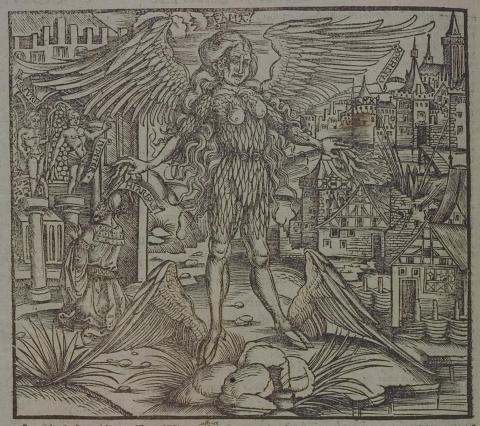Annotations
Rumor [Fama] looms large in the center of the image. She has wings on her back and ankles (180), and multiple ears on the side of her face (183). Her torso is covered with feathers (181). A truly monstrous creature, she is depicted with fire coming from her hands and hoofed feet. She has flown through Carthage and other unnamed Libyan cities (173). On the left, King Iarbas [Hiarbas] hears of Dido's "marriage" to Aeneas (196-7) and prays to Jupiter (198-218) and Mercury to punish Dido, who snubbed Iarbas's marriage offers (211-4). In the text, Iarbas does not address Mercury; instead, Jupiter turns to Mercury to help him bring about what Iarbas has requested (219-37). (Katy Purington)
Woodcut illustration from the “Strasbourg Vergil,” edited by Sebastian Brant: Publii Virgilii Maronis Opera cum quinque vulgatis commentariis expolitissimisque figuris atque imaginibus nuper per Sebastianum Brant superadditis (Strasbourg: Johannis Grieninger, 1502), fol. 215v, executed by an anonymous engraver under the direction of Brant.


Sebastian Brant (1458–1521) was a humanist scholar of many competencies. Trained in classics and law at the University of Basel, Brant later lectured in jurisprudence there and practiced law in his native city of Strasbourg. While his satirical poem Das Narrenschiff won him considerable standing as a writer, his role in the transmission of Virgil to the Renaissance was at least as important. In 1502 he and Strasbourg printer Johannes Grüninger produced a major edition of Virgil’s works, along with Donatus’ Life and the commentaries of Servius, Landino, and Calderini, with more than two hundred woodcut illustrations. (Annabel Patterson)